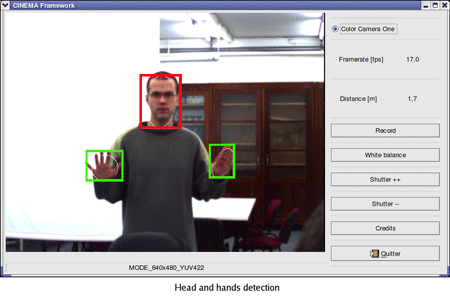
This issue in pdf Subscription Archive: Next issue: October 2005 |
|
|||
The CINEMA Project: A Video-Based Human-Computer Interaction System for Audio-Visual Immersionby Renaud Dardenne, Jean-Jacques Embrechts, Marc Van Droogenbroeck and Nicolas Werner Numerous studies are currently focusing on the modelling of humans and their behavior in 3D environments. The CINEMA project has similar goals but differentiates itself by aiming at enhanced interactions, the creation of mixed reality, and the creation of interactive and reactive acoustical environments. Part of the project consists in gesture recognition of a user, who is given the real-time control of auralization and audio spatialization processes. The CINEMA project is a collaborative effort between teams at four Belgian universities. The project foresees the development of a real-time system that includes 3D user and environment modelling, extraction of motion parameters, gesture recognition, computation of depth maps, creation of virtual spaces, and auralization and spatialization. The merging of these techniques is expected to produce a tractable 3D model allowing users to interact with a virtual world. Although much progress has been made in the areas of video and audio processing, there is still a need to find a way of properly combining these elements. The production of a tool for augmented or virtual reality that mixes video and audio could be used for a number of applications: as an educational tool for example, or at cultural places like museums. This project started on January 2003 and will end in September 2006. It is funded by the Walloon Region, Belgium. Following are details regarding the video-handling techniques and the interaction with the sound system: The Video Analysis Engine Once regions with skin have been detected, we must distinguish between the head and the hands. It is hard to propose a fast and general method that would consider all possible pathological cases for the relative positions of skinned regions. Therefore we rely on the assumption that the head lies in the middle of the region with motion. The final system is capable of recognizing simple hand positions (both hands raised above the head, both hands on the same side of the body etc), and sending appropriate instructions to the audio subsystem (see the Figure).
The Audio Subsystem The Communication Channel between the Video and Audio Subsystems Link: Please contact: Renaud Dardenne, Université de Liège, Belgium Jean-Jacques Embrechts, Université de Liège, Belgium Marc Van Droogenbroeck, Université de Liège, Belgium |
|||


